Check it Out: 10 Ways to Stop Shopping Cart Abandonment
October 2011
By The Architect
It’s not over until the cash register rings
A customer has found your site, browsed your store and added several items to their cart. You’re home free, right?
No so fast...until they’ve confirmed their purchase, you’re still at zero, and you still have plenty of opportunities to derail the sale.
Fatal flaws in your checkout process can not only cost you the potential sale at hand but also drastically decrease the likelihood of that customer ever returning to your site to buy from you in the future.
If you’re experiencing a high occurrence of shopping cart abandonment, here are 10 ways to fix the obstacles and annoyances that are driving away customers and crippling your conversion rates:
1. Eliminate all chance of unpleasant surprises.
Make sure customers have all the information they need upfront to make a confident buying decision. This includes confirming the availability of the item; calculating promotional pricing or discounts; mapping out shipping options, costs and timetables; specifying whether or not sales tax applies to the purchase and clearly defining your return policy.
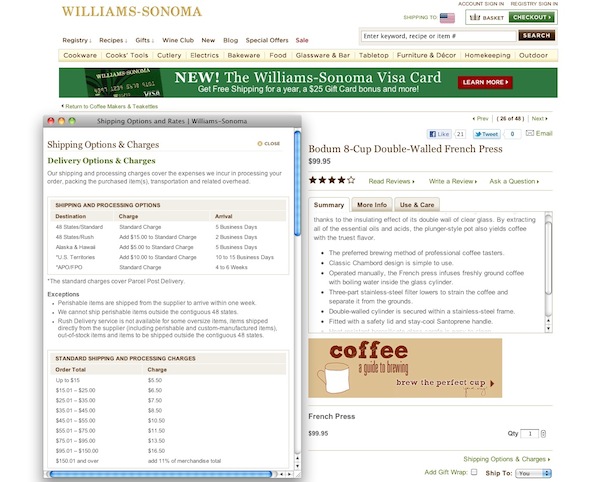
If a customer reaches checkout only to discover that the particular item they wanted is out of stock, ineligible for an advertised discount or costs more to ship than they are willing to pay, odds are good that will be the last you see of them.
2. Display relevant details in the cart.
The shopping cart itself should provide a clear overview of the pending purchase at a glance so that customers do not have to navigate away from the checkout process to confirm the details of their order.
Keep in mind that by this point in the process, your shopper may well have clicked to and from the cart numerous times as they selected multiple items, browsed various categories of products or compared one item to another, and they may be fuzzy on the specifics of everything they’ve chosen.
Without the benefit of being able to glance down into a physical shopping cart to review their selections, they need reassurance that the package that lands on their doorstep will contain exactly what they intend, so be sure to provide thumbnail images, descriptions, quantities, sizes, colors, prices, availability and applicable discounts for each product in the cart.
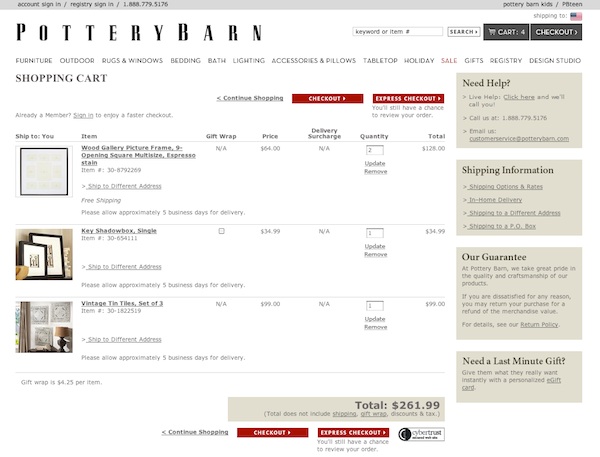
3. Allow changes within the cart.
Every time your customer navigates away from the cart, you’re running the risk of losing them, so make sure that they can edit details such as quantity, size and color without having to locate the product page a second time.
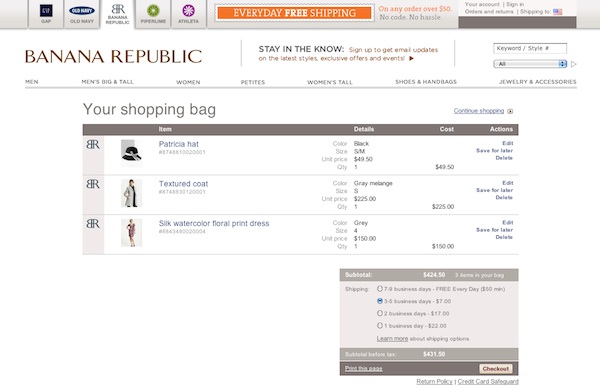
4. Offer multiple payment options.
If you’re conducting e-commerce business online, your site should be tied in to a secure payment gateway. However, offering the option to complete the transaction through a third-party processor like PayPal or Google Checkout can put some customers – especially those who may not shop online often – at ease because they don’t have to release their credit card number and billing information directly to you.
Conversely, PayPal and Google Checkout shouldn’t be the only options you provide. If a customer does not already have an account established with one of these payment processors, they may not want to create one just to do business with you.
5. Don’t require customers to create an account.
Without a doubt, it’s awfully tempting to require customers to create an account to complete their purchase because it will allow you to collect valuable data from them for future sales analysis and marketing.
However, given the sheer number of social media and e-commerce sites that your customers likely interact with, they may very well have account creation fatigue. They may not want to establish yet another user account and password just to make a purchase, especially if they don’t necessarily anticipate ordering from you again in the near future.
The best approach is to offer two options: checking out as a guest, which will expedite the process, or creating an account, which offers conveniences appealing to those who do shop with you often, such as eliminating the need to re-enter their shipping and billing information every time they make a purchase and allowing them to check on the status of an order.
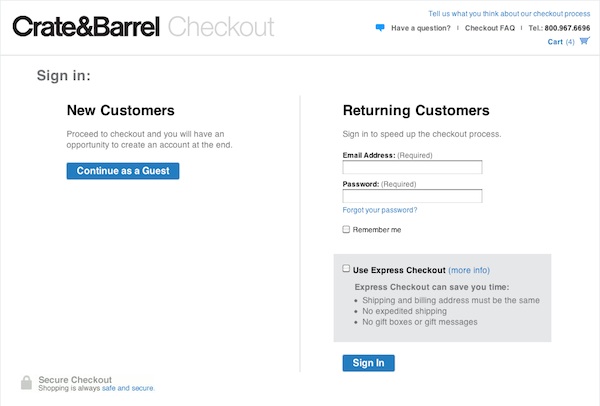
The key is to let your customer make the choice that suits them best; don’t force the issue and lose a sure sale in pursuit of future marketing opportunities.
6. Simplify and streamline.
Online shoppers are notoriously impatient, so don’t ask for more information than you need to complete the transaction, and don’t break the checkout process into more steps than necessary.
Make sure as well to display a breadcrumb trail that indicates how the checkout process will progress. If a customer can see at step one that they only have three steps left to complete their order, they won’t get impatient or frustrated as they move from one screen to the next, not knowing what’s coming next or when the process will be done.
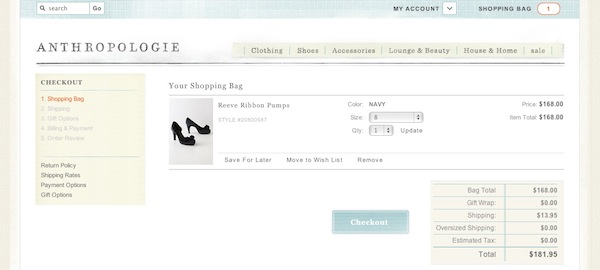
7. Cater to the on-the-go shopper.
When evaluating your checkout process, don’t forget about mobile users. A customer may be standing in the bricks-and-mortar store of your competitor and comparison shopping on their phone. If you offer the better price, don’t you want to make it as easy as possible for this customer – who’s clearly ready to buy – to order from you on the spot instead?
This is another reason why it’s critical to streamline the steps within your checkout process as much as possible as well as to ensure that form fields can be easily completed on touch-based devices.
Walk through your checkout process on as many different types of mobile devices and platforms as you can get your hands on, and don’t waste any time in eliminating any obstacles or road blocks that you discover.
8. Don’t give up too soon.
In the age of multitasking, sometimes a customer will simply get distracted before they have a chance to complete their transaction. The phone rings, the baby wakes up from her nap, the computer freezes, the pizza delivery guy arrives, etc.
Or sometimes, they just need some extra time to make a decision while they continue to do research, get opinions from friends and the like. While you can’t do anything to mitigate this type of offline interference, you still have a chance to save the sale.
A persistent shopping cart retains the items your customer has selected for a set period of time, whether that’s a few hours or a few days. When your customer has a chance to return to their computer, they can pick up exactly where they left off rather than facing the hassle of tracking down each item again, even if they had closed their browser window.
9. Never underestimate the importance of the human element.
If your customer has a question as they are progressing through checkout, the easiest, most reliable way to ensure they don’t lose momentum is to display your customer service phone number prominently at every step along the way.
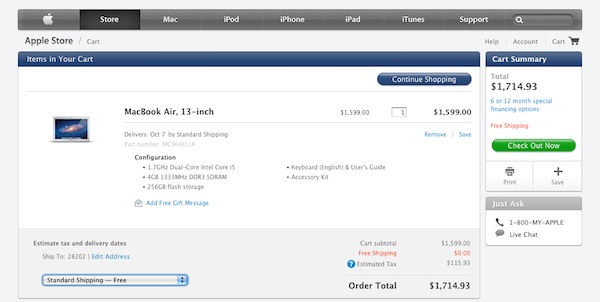
A simple question should have a simple resolution, and usually that is best provided in real time by a human being. If you leave your customers to their own devices to find the answers they need, you’re running the risk of allowing them to become distracted or frustrated and losing all interest in completing the order.
10. Reinforce trust at every turn.
As with all elements of doing business online, trust is key. In the absence of face-to-face human contact, you must rely on your website to build trust for you if you want customers to choose to spend their hard-earned dollars with you rather than with your competitor.
Some elements of trust-building in e-commerce are obvious. Do you display your SSL certificate to reinforce security? Do you feature customer testimonials or reviews to boost confidence in your reputation? Is it easy to locate your company’s phone number, physical address and return policies so they feel assured that they can resolve a problem or obtain a refund without hassle?
Other elements are less tangible. Does your site have a polished, refined look and feel overall, or does it look dated or sketchy? Do you offer value-added content like how-to videos or blog articles that convey to your customers that they are doing business with experts who are knowledgeable and passionate about their products?
Thanks to the proliferation of Internet scam artists, the burden of earning trust with online shoppers is steep, but it is surmountable with careful attention to detail.
Behind every superstar website there is an architect, scrutinizing every single detail, cutting through the nonsense, and challenging every aspect to craft a masterpiece that gets noticed and gets results.